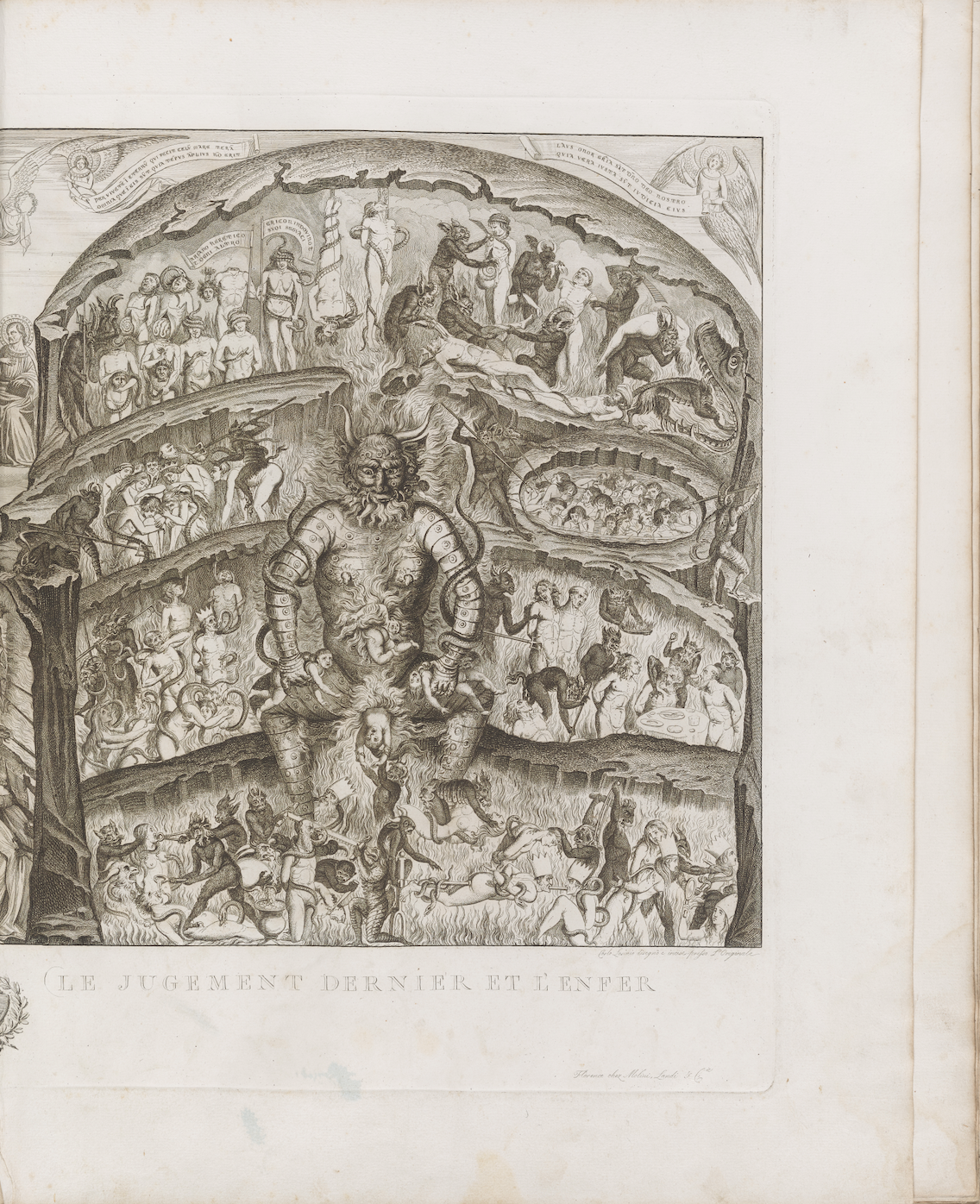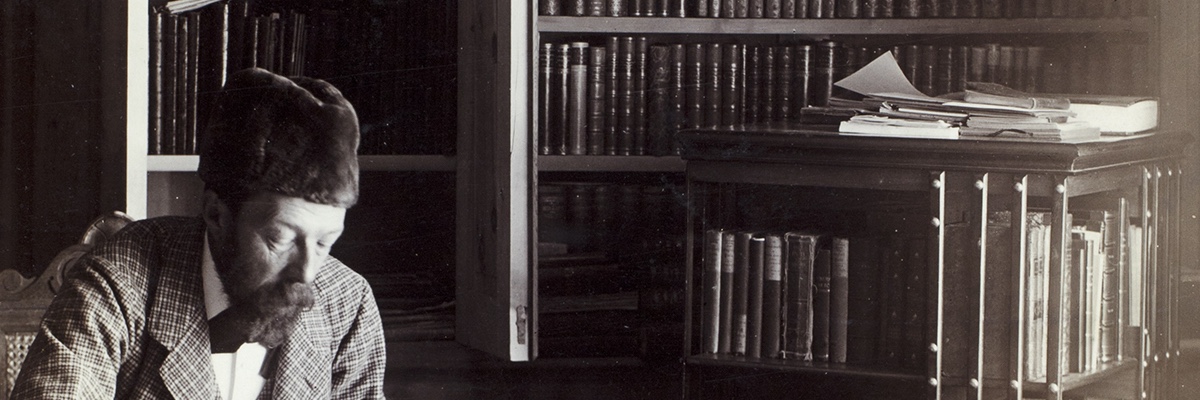
The above image comes from Carlo Lasinio’s book Pitture a fresco del Campo Santo di Pisa. This book contains 40 double plates and was published in Florence in 1812. The engravings in this large, beautiful book are Carlo Lasinio’s personal reproductions of the frescos at the Campo Santo in Pisa. This particular image that I have chosen to write about is entitled “Le Jugement Dernier et Enfer” which translates to “The Last Judgement and Hell” and is a Biblical reference that has been depicted by countless artists throughout history. This book is mentioned by John Addington Symonds in his Memoirs and this book, along with many other plate books, were located in Symonds’ family library and were particularly influential in his youth.
On page 18 of his Memoirs, Symonds writes: “I was very fond of picture books and drew a great deal from Raphael, Flaxman and Retzsch. Our house was well stocked with engravings, photographs, copies of Italian pictures and illustrated works upon Greek sculpture. Lasinio’s Campo Santo of Pisa, Sir William Hamilton’s vases, the Museo Borbonico and the two large folios issued by the Dilettante Society were among my chief favourites.”[1] It is no surprise that, given his interest in Greek and Roman antiquity, Symonds would find these Italian engravings of interest and that they would have been revered by not only Symonds but also his father, the senior John Addington Symonds. While perhaps not a direct influence on a book like A Problem in Greek Ethics, it is likely that engravings such as those by Lasinio would have influenced Symonds’ books on the Italian Renaissance and perhaps even his visits to Pisa later in his adult life. I myself have been to the Campo Santo in Pisa and it truly is stunning.
The frescos at the Campo Santo depict religious scenes and were painted during the High Renaissance. The particular image that I have chosen is of the Last Judgement, and, more specifically, Hell. The archangel Michael and the Last Judgement are seen on the left-hand side of the page while Hell can be seen on the right-hand side. Arguably the most famous depiction of these scenes is by Michelangelo and is located on one of the walls of the Sistine Chapel. Lasinio’s depiction of Hell is honestly quite horrifying, which is one of the reasons why I was so drawn to it and I can imagine a young John Addington Symonds being quite intrigued by this engraving as well. Lasinio has included an incredible amount of detail in this engraving and has not hesitated to include some very gruesome images, such as a monstrous Devil consuming and giving birth to people in the center of the plate, men being strangled by serpents, roasted on spits, having their entrails pulled out, and so many more horrible tortures that, according to some theologians, await those who are sent to Hell. The entire scene is also quite reminiscent of Dante’s description of the nine circles of Hell in his Inferno. Dante is another author who we know Symonds read and is mentioned in his Memoirs, providing further context for this plate in the life of Symonds.
Additionally, it is quite interesting to consider this image keeping in mind Symonds’ religious background as well as the various ailments that plagued him as a child. In Chapter 1 of the Memoirs, Symonds writes:
“I was persuaded that the devil lived near the door-mat in a dark corner of the passage by my father’s bedroom. I thought that he appeared to me there under the shape of a black shadow, skurrying about upon the ground, with the faintest indication of a slightly whirling tail.
When the cholera was raging in the year 1848, I heard so much about it that I fell into a chronic state of hysterical fear. Someone had told me of the blessings which attend ejaculatory prayers. So I kept perpetually mumbling: ‘Oh, God, save me from the cholera!’ This superstitious habit clung to me for years. I believe that it obstructed the growth of sound ideas upon religion; but I cannot say that I ever was sincerely pious, or ever realized the language about God I heard and parroted.”
(Memoirs, Chapter 1, pg 69)
This is just one section of the Memoirs that show the extreme influence that religion and fear of disease had on Symonds. Symonds himself wrote about the extent to which he “loathed evangelic Protestantism” (Chapter 1, page 67) and it is very likely that this image, in conjunction with his poor health as a child and his staunch, nonconformist values on religious would have provoked quite a violent response on the young boy. It is possible that Symonds himself might have even identified with the writhing, tortured figures that Lasinio depicts and may have stirred up some deeper emotions within his heart and soul as a young, sick boy coming to terms with his sexuality, morals, and beliefs.
All in all, it is quite interesting to consider an image of Hell in connection to the life of John Addington Symonds and his interests. The ancient Greeks and Romans had a quite different conception of Hell that was manifested in the Underworld, a place that is under the rule of Pluto (or Hades), guarded by a three-headed dog named Cerberus, and reached by crossing the River Styx with Charon, the ferryman. The Underworld of antiquity looks quite different from both Dante and Lasinio’s Biblical versions of Hell in which non-Christians and pagans such as Aristotle and Homer are placed. Symonds undoubtedly was familiar with both of these versions of Hell and understood their distinctions. In my own mind, I am interested to know what Symonds’ personal thoughts surrounding homosexuality and Hell looked like. It is an unfortunate but common belief held by many Christians that homosexuals belong in Hell due to the word of God and what is written in the Bible but I am unfamiliar with what of this directly impacted Symonds’ life and what he had to deal with as a man who was romantically and sexually attracted to other men. Obviously, that same kind of condemnation was not the attitude towards same-sex relationships in antiquity so this is another layer that I would be interested in looking at more closely and was sparked by my viewing of Lasinio’s engraving of a particularly disturbing depiction of Hell.
[1] John Addington Symonds and Amber K. Regis, The Memoirs of John Addington Symonds: a Critical Edition (London: Palgrave Macmillan, 2016), 118.

One thought on “One Hell of a Time: Pitture a fresco del Campo Santo di Pisa and a Young Symonds”